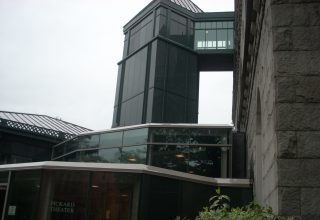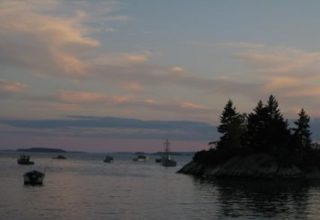
(excerpted from “Integral Leadership Coaching: A Partner in Sustainability” by Lloyd Raines, published March 2007, Integral Leadership Review.)
How do coaches explore the moral dimensions Climate change is dramatically altering the way we understand ourselves and our relationship with the world around us? Recent instabilities in our climatic and weather patterns have forced leaders in the private, public, and civil sectors to take stock and focus on these structural shifts. Little by little, the realities of climate change are forging a re-examination of how we live, produce, consume, and create waste. We are seeing the web of relationships between nature and our economy – and how the very design of our economic system is problematic. We are being educated about renewable and non-renewable resources, the concept of ―the global commons,‖ and tipping points in living systems. And in the process, we are beginning to see more clearly the inter-related nature of economic, ecological, and social well-being.
Even though scientists have been warning policy makers for years of the growing impact of global warming, deforestation, pollution, topsoil erosion, overpopulation, and other critical trends, we are just now in the beginning phase of seriously confronting these crises. We are on a collision path with new global trends that make our way of life more and more untenable.
It has taken over 40 years for the accumulation of scientific research to gradually make its way into the American political dialogue in earnest. A political tipping point in the dialogue occurred in early 2007 when President Bush first acknowledged the reality of global warming. Up until that point, a sliver of influential naysayers and critics managed to forestall any politically-focused efforts from the executive branch. Once acknowledged by the president, however, daily talk about climate change has mushroomed. Ordinary citizens have become more attuned to the importance of carbon emissions, cap and trade policies, ecological footprints, hybrid cars, and the need to re-think and change the very design of how we live and work.
We seem to be on the verge of a paradigm shift, moving from a deeply fragmented way of seeing life to one rich with coherence. After hundreds of years of industrial progress defined as growth and consumption, extracting resources, dumping toxins into the soil, air, water, and wildlife, nature has reached absorption points and is no longer able to cleanse the toxins or replenish its resources. Nature is undergoing structural challenges to its homeostasis in all its major living systems.
With the climb in atmospheric CO2 levels from industry and transportation emissions, vast ice sheets are melting, and the receding ice is releasing methane (23 times more powerful than carbon dioxide) from the previously frozen tundra. The release of methane gas creates a reinforcing cycle of negative feedback loops, accelerating the pattern of global warming. While the impact of melting ice may be hard to grasp in its implications, there are other symptoms of global warming that are easier to recognize: the progressively hot summers and milder winters, in the US and Europe; more extreme weather conditions – including the number and ferocity of storms, the duration of draughts, and intensity of floods. Climate and weather patterns are changing in front of our eyes.
Ironically, it is the long-term impact of our short-term profit and production system that has brought us full-circle, back to an awareness of our place in the natural order. The crisis of climate change finally re-positions science ahead of ideology, bringing an honest accounting of the full costs (internal and external) of our systems of production and consumption.
Beyond the traditional bottom line concern for financial success, a triple bottom line (TBL) perspective includes strategic concern for social and environmental health and well-being, as well. TBL companies treat all three bottom lines as primary and inextricably linked in the company’s strategic plans, goals, and metrics. Over the past 10-15 years, many well-known corporate leaders have come to their own judgments about what good, sustainable business should look like. Johnson & Johnson, Interface, Goldman Sachs, Unilever, Dow, DuPont, Hewlett Packard, Patagonia, Starbucks, and a long list of other familiar companies comprise TBL companies. (For one version of the list, see Esty and Winston 2006, p. 314). Even Wal-Mart has initiated some of the most forward-thinking environmental initiatives in the past year, while also beginning to address concerns raised by critics of its social bottom line record (a lack of health care coverage, low wages, and gender bias).
It is within this larger set of forces that leaders operate today. Leaders who acknowledge and embrace the reality of climate change sooner will be better able to act as responsible stewards for their organization’s resources (financial, human, technical, and natural), and keep their companies viable. Embracing climate change’s impact is, at its core, a holistic and systems based awareness—connecting the dots between people’s thinking, actions, culture, and systems within the broader social, economic and ecological systems within which we live.
Many of these TBL companies previously had been major polluters, yet without being forced by government regulation, they chose to respond to the science-based trends, take the long view on their corporate and fiduciary responsibilities, and change the very design of how they envisioned and implemented their business model.
Prior to early 2007, the concept of ―sustainability‖ was on the fringe of mainstream awareness. Yet, every day it is becoming more mainstream, part of the daily dialogue, and the way news reports are framed. Hundreds of major companies and thousands of smaller businesses have been addressing sustainability in a disciplined, strategic way for well over a decade. Of late, the general public, politicians, and federal government have tipped to acceptance of global warming by the combined impact of former Vice President Al Gore’s film ―An Inconvenient Truth,‖ Britain’s recently released ―Stern Review Report on the Economics of Climate Change‖ (HM Treasury 2006), and the international ―Intergovernmental Panel on Climate Change‖ (http://www.ipcc.ch/). These reports acknowledge what has been obvious to scientists worldwide for quite some time. The reality of climate change is no longer in question. What does this mean for leaders? What does this mean for coaches?
Over the past few years, I have been surprised and at times startled by the lack of awareness and active discussion of sustainability and climate change trends in the companies and federal agencies where I coach. What I hear instead are responses about a diverse set of opinions regarding climate change’s relevance or veracity. In the heartland of organizational life, these external factors haven’t yet shown up on the agendas or in strategic conversations of most workplace leaders. Yet, an integral coaching conversation with a leader that raises awareness of certain issues at one point in time may find that six months later (or even less) this new awareness is now leading to sustainability conversations and actions.
For now, though, I want to leave behind the larger social and environmental context, and drop into the person-to-person level where all coaching begins.
Where Coaching Starts
When we’re invited to be interviewed as a potential coach for a leader, we may hear some specific developmental focal points like: enhance communication skills, cultivate leadership presence, sustain high performance, delegate more, mentor others, improve work-life balance, or enhance relationships and networks. At some point, the leader will want to know what is the coach’s method or philosophy. Each coach responds uniquely, giving his or her approach to serving and partnering with leaders.
The scope of integral coaching addresses four key areas of leadership competence, and these are what I talk about when being interviewed by the leader. I seek to support their effectiveness through heightened holistic awareness and intentional actions that strengthen resilience and sustainability in terms of their:
Personal interior (worldview, beliefs, intentions, thoughts, emotions, sensations, spirit),
Personal exterior (actions, reactions, body language, voice, tone, expressions, etc.),
Collective interior (unspoken cultural norms, values, and beliefs), and
Collective exterior (expressed values and beliefs-in-action, social behaviors, business & economic policies and systems, ecological systems, etc.)
I have found it valuable up front to employ a holistic framework for appreciating a leader’s experience. In sharing this lens with them, they begin to stretch and stimulate their capacity for systems thinking – strengthening their understanding of the links between their internal and external realities. Most clients find this approach intriguing. They often say that it speaks to the rich context of their experience.
The Invitation into the Leader’s World
When leaders invite coaches into their private worlds, they share many aspects of their private reality. We hear unguarded thoughts and feelings, observe behavioral messages in posture and affect, sense subtle mood and energy shifts. We ask questions that, perhaps, few others might feel safe to ask, and do so with the blessings of the leader. They want someone to speak directly with them and to them. We are “inside the kimono,‖ building trust and safety.
To get familiar with the leader’s world, coaches meet with them personally, perhaps ―shadow‖ them as they go about their work, and may also coach their teams. We interview peers, direct reports, supervisors and sometimes spouses to learn more about who they are and how they go about leading and living. What vision do they convey and embody? What attitudes and feelings do they engender in others in the leadership team and broader organization? How conscious are they of enriching the diversity of the workplace and input into their discussions? Getting a sense of their work-life balance is important to know – how and when do they relax, spend quality time with their family, and rejuvenate? How do they connect (or not) with important stakeholders? Also, coaches read the leader’s 360 feedback reports and performance evaluations. In the process, we learn a great deal about them, their organization’s culture, structure, and systems, gaining an appreciation for the complex context within which these leaders work.
Recently, I reviewed the files of 50 leaders with whom I’ve worked in the last few years and listed the issues they chose to work on. Not surprisingly, the lion’s share had to do with enhancing the effectiveness and impact of their communication as key to their leadership effectiveness. Communication may have taken the form of improving certain skills like presenting, listening, inquiry, dialogue, building team cohesion, driving outcomes, or cultivating group intelligence instead of simply leading meetings. Often, though, communication is a function of a leader’s interior development—including awareness of their stories and mental models, managing their emotions (including ―triggers,‖ ―shadows,‖ and ―projections‖), strengthening their authenticity, walking their talk, and generally attuning their mind, body, emotions, and spirit for enhanced effectiveness in communicating, leading, and driving change. And, at times, leaders wanted assistance on positively impacting the organization’s culture, bringing about more accountability, collaborating to dissolve silos, maintaining mutual respect, and building esprit de corps. Often, to achieve these improvements, changes would need to be made in some practices, policies, systems, or structures.
When a leader is entering the top tier of leadership ranks, the challenge for them is to make a qualitative transition from one kind of leading to another. At these pivotal points, leaders recognize their former managerial mastery as no longer what is being asked for or valued. Instead they are being called to a different way of engaging the company’s vision, with a broader strategic view, and a more sophisticated communication and networking acumen with stakeholders. They will have to let go of trusted markers and competitive strategies that got them to the top of their game up to this point. And, they will begin learning new approaches for leveraging value.
Coaches help leaders bridge these transitions through dialogue, reflection, targeted readings, and experiments in learning—using self-awareness exercises and behavioral practices to create new habits. What an integral approach does for me, as a coach, is to help me pay attention to the presenting issue while stepping back conceptually and wondering how other dimensions might play into supporting or getting in the way of moving this leader’s overall operating model from one level to the next.

















